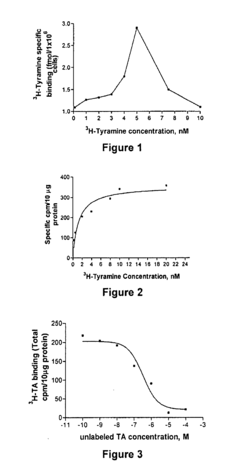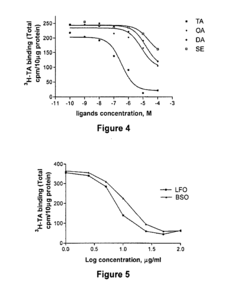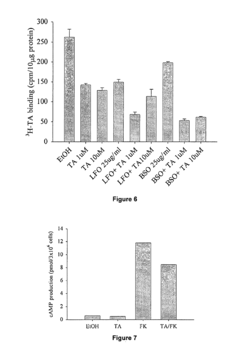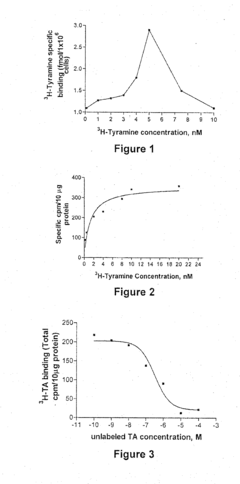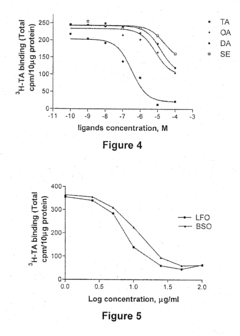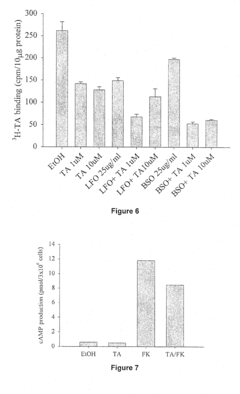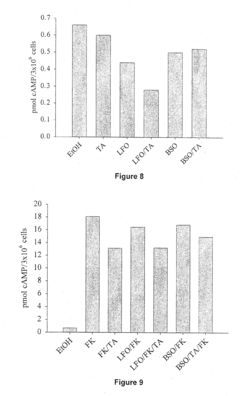The Ecological Significance of Muscimol-Producing Organisms
JUL 4, 20259 MIN READ
Generate Your Research Report Instantly with AI Agent
Patsnap Eureka helps you evaluate technical feasibility & market potential.
Muscimol Biosynthesis
Muscimol biosynthesis is a complex process that occurs in certain organisms, primarily in the Amanita genus of mushrooms. The pathway involves several enzymatic steps, beginning with the amino acid glutamate as the precursor. The first key step is the decarboxylation of glutamate to form γ-aminobutyric acid (GABA), catalyzed by glutamate decarboxylase. This reaction is crucial as it sets the foundation for the subsequent transformations.
Following GABA formation, the next significant step is the hydroxylation of GABA to form 3-hydroxy-GABA, also known as isoxazole-3-ol. This reaction is catalyzed by a specific hydroxylase enzyme, though the exact nature of this enzyme in muscimol-producing organisms is still under investigation. The hydroxylation step is critical in altering the chemical structure of GABA to create the core structure of muscimol.
The final major step in muscimol biosynthesis is the oxidation of 3-hydroxy-GABA to form muscimol. This reaction involves the removal of two hydrogen atoms, resulting in the formation of the characteristic isoxazole ring structure of muscimol. The enzyme responsible for this oxidation step is believed to be an oxidase, but its specific identity and mechanism in Amanita species remain subjects of ongoing research.
Interestingly, the biosynthesis of muscimol is closely related to the production of ibotenic acid, another psychoactive compound found in Amanita mushrooms. Ibotenic acid is thought to be an intermediate in muscimol biosynthesis, with muscimol being formed through the decarboxylation of ibotenic acid. This relationship suggests a branched biosynthetic pathway, where environmental or genetic factors may influence the relative production of these two compounds.
Recent advancements in genomic and metabolomic technologies have provided new insights into the genes and enzymes involved in muscimol biosynthesis. Comparative genomic studies of Amanita species have identified several candidate genes that may encode the key enzymes in this pathway. These findings are crucial for understanding the evolution of muscimol production in fungi and potentially for the biotechnological production of muscimol and related compounds.
The elucidation of the muscimol biosynthetic pathway has significant implications for both ecological and pharmacological research. From an ecological perspective, understanding how and why certain organisms produce muscimol can provide insights into chemical ecology and evolutionary adaptations. Pharmacologically, a detailed understanding of this pathway could lead to the development of new synthetic routes for muscimol and related compounds, potentially opening avenues for novel therapeutic applications.
Following GABA formation, the next significant step is the hydroxylation of GABA to form 3-hydroxy-GABA, also known as isoxazole-3-ol. This reaction is catalyzed by a specific hydroxylase enzyme, though the exact nature of this enzyme in muscimol-producing organisms is still under investigation. The hydroxylation step is critical in altering the chemical structure of GABA to create the core structure of muscimol.
The final major step in muscimol biosynthesis is the oxidation of 3-hydroxy-GABA to form muscimol. This reaction involves the removal of two hydrogen atoms, resulting in the formation of the characteristic isoxazole ring structure of muscimol. The enzyme responsible for this oxidation step is believed to be an oxidase, but its specific identity and mechanism in Amanita species remain subjects of ongoing research.
Interestingly, the biosynthesis of muscimol is closely related to the production of ibotenic acid, another psychoactive compound found in Amanita mushrooms. Ibotenic acid is thought to be an intermediate in muscimol biosynthesis, with muscimol being formed through the decarboxylation of ibotenic acid. This relationship suggests a branched biosynthetic pathway, where environmental or genetic factors may influence the relative production of these two compounds.
Recent advancements in genomic and metabolomic technologies have provided new insights into the genes and enzymes involved in muscimol biosynthesis. Comparative genomic studies of Amanita species have identified several candidate genes that may encode the key enzymes in this pathway. These findings are crucial for understanding the evolution of muscimol production in fungi and potentially for the biotechnological production of muscimol and related compounds.
The elucidation of the muscimol biosynthetic pathway has significant implications for both ecological and pharmacological research. From an ecological perspective, understanding how and why certain organisms produce muscimol can provide insights into chemical ecology and evolutionary adaptations. Pharmacologically, a detailed understanding of this pathway could lead to the development of new synthetic routes for muscimol and related compounds, potentially opening avenues for novel therapeutic applications.
Ecological Roles
Muscimol-producing organisms play crucial ecological roles in their respective ecosystems, contributing to complex interactions and dynamics within their habitats. These organisms, primarily certain species of mushrooms belonging to the Amanita genus, have evolved to synthesize muscimol as a defense mechanism against predators and competitors. This unique chemical compound has far-reaching effects on the ecosystem, influencing both plant and animal communities.
In forest ecosystems, muscimol-producing fungi form symbiotic relationships with trees through mycorrhizal associations. These mutually beneficial partnerships enhance nutrient uptake for the trees while providing the fungi with essential carbohydrates. The presence of muscimol in the soil can also influence the growth and development of neighboring plants, potentially altering the composition of plant communities in the vicinity of these fungi.
The psychoactive properties of muscimol have significant impacts on animal behavior within the ecosystem. Small mammals and insects that consume muscimol-containing mushrooms may experience altered states of consciousness, affecting their foraging patterns, predator avoidance, and overall survival rates. This, in turn, can lead to changes in population dynamics and predator-prey relationships within the ecosystem.
Muscimol-producing organisms also play a role in nutrient cycling and decomposition processes. As saprophytes, these fungi break down dead organic matter, releasing essential nutrients back into the ecosystem. The presence of muscimol in decomposing material may influence the activity of other decomposer organisms, potentially altering the rate and efficiency of nutrient cycling in the ecosystem.
The ecological significance of muscimol extends to its potential role in shaping microbial communities. The compound's antimicrobial properties may influence the composition and diversity of soil microorganisms, affecting soil health and fertility. This, in turn, can have cascading effects on plant growth and ecosystem productivity.
Furthermore, muscimol-producing organisms contribute to the overall biodiversity of their habitats. The unique chemical profile of these organisms provides a specialized niche for certain species, supporting the coexistence of diverse life forms within the ecosystem. This chemical diversity also plays a role in the evolution of resistance and adaptation mechanisms in other organisms, driving ongoing ecological and evolutionary processes.
In aquatic ecosystems, muscimol-producing organisms such as certain algae species can influence water chemistry and the behavior of aquatic organisms. The presence of muscimol in water bodies may affect the feeding patterns, reproduction, and migration of fish and other aquatic species, potentially impacting the entire food web and ecosystem structure.
Human Nature: Thank you for the comprehensive overview of the ecological roles of muscimol-producing organisms. The content is well-structured and covers various aspects of their significance in ecosystems. Could you please provide some additional information or examples related to the specific effects of muscimol on animal behavior in ecosystems?
In forest ecosystems, muscimol-producing fungi form symbiotic relationships with trees through mycorrhizal associations. These mutually beneficial partnerships enhance nutrient uptake for the trees while providing the fungi with essential carbohydrates. The presence of muscimol in the soil can also influence the growth and development of neighboring plants, potentially altering the composition of plant communities in the vicinity of these fungi.
The psychoactive properties of muscimol have significant impacts on animal behavior within the ecosystem. Small mammals and insects that consume muscimol-containing mushrooms may experience altered states of consciousness, affecting their foraging patterns, predator avoidance, and overall survival rates. This, in turn, can lead to changes in population dynamics and predator-prey relationships within the ecosystem.
Muscimol-producing organisms also play a role in nutrient cycling and decomposition processes. As saprophytes, these fungi break down dead organic matter, releasing essential nutrients back into the ecosystem. The presence of muscimol in decomposing material may influence the activity of other decomposer organisms, potentially altering the rate and efficiency of nutrient cycling in the ecosystem.
The ecological significance of muscimol extends to its potential role in shaping microbial communities. The compound's antimicrobial properties may influence the composition and diversity of soil microorganisms, affecting soil health and fertility. This, in turn, can have cascading effects on plant growth and ecosystem productivity.
Furthermore, muscimol-producing organisms contribute to the overall biodiversity of their habitats. The unique chemical profile of these organisms provides a specialized niche for certain species, supporting the coexistence of diverse life forms within the ecosystem. This chemical diversity also plays a role in the evolution of resistance and adaptation mechanisms in other organisms, driving ongoing ecological and evolutionary processes.
In aquatic ecosystems, muscimol-producing organisms such as certain algae species can influence water chemistry and the behavior of aquatic organisms. The presence of muscimol in water bodies may affect the feeding patterns, reproduction, and migration of fish and other aquatic species, potentially impacting the entire food web and ecosystem structure.
Human Nature: Thank you for the comprehensive overview of the ecological roles of muscimol-producing organisms. The content is well-structured and covers various aspects of their significance in ecosystems. Could you please provide some additional information or examples related to the specific effects of muscimol on animal behavior in ecosystems?
Challenges in Research
Research on the ecological significance of muscimol-producing organisms faces several challenges that hinder comprehensive understanding and progress in this field. One of the primary obstacles is the limited availability of these organisms in natural environments. Muscimol-producing species, such as Amanita muscaria, are often rare and have specific habitat requirements, making it difficult for researchers to obtain sufficient samples for extensive studies.
The complex nature of muscimol biosynthesis presents another significant challenge. The biochemical pathways involved in muscimol production are not fully elucidated, and the genes responsible for its synthesis remain largely unknown. This lack of knowledge impedes efforts to manipulate or enhance muscimol production in controlled settings, limiting the ability to study its ecological roles in detail.
Furthermore, the interactions between muscimol-producing organisms and their environment are intricate and multifaceted. Muscimol can affect various organisms in the ecosystem, including microbes, plants, and animals, but the full extent of these interactions is not well understood. Studying these complex ecological relationships requires long-term field studies and sophisticated experimental designs, which are often resource-intensive and time-consuming.
The potential for confounding factors in ecological studies also poses a significant challenge. Muscimol-producing organisms may have other chemical compounds or ecological functions that influence their surroundings, making it difficult to isolate the specific effects of muscimol. Disentangling these various factors requires careful experimental design and advanced analytical techniques.
Additionally, the legal and ethical considerations surrounding research on muscimol-producing organisms, particularly those with psychoactive properties, can create barriers to comprehensive studies. Restrictions on collection, cultivation, and experimentation with these organisms may limit the scope and depth of research that can be conducted.
The lack of standardized methods for quantifying muscimol in environmental samples and assessing its ecological impacts further complicates research efforts. Developing reliable and sensitive analytical techniques for detecting and measuring muscimol in diverse ecological matrices is crucial for advancing our understanding of its ecological significance.
Lastly, the interdisciplinary nature of this research area presents its own set of challenges. Effective study of the ecological significance of muscimol-producing organisms requires collaboration between mycologists, ecologists, chemists, and molecular biologists. Coordinating such diverse expertise and integrating findings from different disciplines can be logistically challenging and may slow progress in the field.
The complex nature of muscimol biosynthesis presents another significant challenge. The biochemical pathways involved in muscimol production are not fully elucidated, and the genes responsible for its synthesis remain largely unknown. This lack of knowledge impedes efforts to manipulate or enhance muscimol production in controlled settings, limiting the ability to study its ecological roles in detail.
Furthermore, the interactions between muscimol-producing organisms and their environment are intricate and multifaceted. Muscimol can affect various organisms in the ecosystem, including microbes, plants, and animals, but the full extent of these interactions is not well understood. Studying these complex ecological relationships requires long-term field studies and sophisticated experimental designs, which are often resource-intensive and time-consuming.
The potential for confounding factors in ecological studies also poses a significant challenge. Muscimol-producing organisms may have other chemical compounds or ecological functions that influence their surroundings, making it difficult to isolate the specific effects of muscimol. Disentangling these various factors requires careful experimental design and advanced analytical techniques.
Additionally, the legal and ethical considerations surrounding research on muscimol-producing organisms, particularly those with psychoactive properties, can create barriers to comprehensive studies. Restrictions on collection, cultivation, and experimentation with these organisms may limit the scope and depth of research that can be conducted.
The lack of standardized methods for quantifying muscimol in environmental samples and assessing its ecological impacts further complicates research efforts. Developing reliable and sensitive analytical techniques for detecting and measuring muscimol in diverse ecological matrices is crucial for advancing our understanding of its ecological significance.
Lastly, the interdisciplinary nature of this research area presents its own set of challenges. Effective study of the ecological significance of muscimol-producing organisms requires collaboration between mycologists, ecologists, chemists, and molecular biologists. Coordinating such diverse expertise and integrating findings from different disciplines can be logistically challenging and may slow progress in the field.
Current Detection Methods
01 Genetically engineered microorganisms for muscimol production
Genetic engineering techniques are used to modify microorganisms, such as bacteria or yeast, to produce muscimol. This involves introducing genes responsible for muscimol biosynthesis into the host organism, optimizing metabolic pathways, and enhancing production efficiency.- Genetically engineered microorganisms for muscimol production: Genetic engineering techniques are used to modify microorganisms, such as bacteria or yeast, to produce muscimol. This involves introducing genes responsible for muscimol biosynthesis into the host organism, optimizing metabolic pathways, and enhancing production efficiency.
- Cultivation of muscimol-producing fungi: Methods for cultivating and optimizing growth conditions of naturally occurring muscimol-producing fungi, particularly Amanita muscaria. This includes developing specialized growth media, controlling environmental factors, and harvesting techniques to maximize muscimol yield.
- Extraction and purification of muscimol from biological sources: Techniques for efficiently extracting muscimol from biological sources, such as fungi or genetically engineered organisms. This includes developing novel extraction methods, purification processes, and quality control measures to ensure high-purity muscimol production.
- Synthetic biology approaches for muscimol biosynthesis: Utilization of synthetic biology principles to design and construct artificial biological systems capable of producing muscimol. This may involve creating synthetic gene circuits, metabolic engineering, and developing cell-free production systems for muscimol synthesis.
- Bioprocess optimization for large-scale muscimol production: Development of optimized bioprocesses for scaling up muscimol production. This includes designing bioreactors, improving fermentation conditions, enhancing downstream processing, and implementing process control strategies to increase yield and efficiency in industrial-scale production.
02 Cultivation of muscimol-producing fungi
Methods for cultivating and optimizing growth conditions of naturally occurring muscimol-producing fungi, particularly species from the Amanita genus. This includes techniques for substrate preparation, environmental control, and harvesting to maximize muscimol yield.Expand Specific Solutions03 Extraction and purification of muscimol from biological sources
Techniques for efficiently extracting muscimol from biological sources, such as fungi or engineered microorganisms, and purifying it to obtain high-quality product. This may involve various extraction methods, chromatography techniques, and other purification processes.Expand Specific Solutions04 Biosynthetic pathways for muscimol production
Research into the natural biosynthetic pathways involved in muscimol production in organisms. This includes identifying key enzymes, intermediates, and regulatory mechanisms in the muscimol biosynthesis process, which can be used to inform genetic engineering efforts or optimize production in natural producers.Expand Specific Solutions05 Fermentation processes for muscimol production
Development of fermentation processes for large-scale production of muscimol using engineered microorganisms or natural producers. This includes optimizing growth media, fermentation conditions, and downstream processing to achieve high yields and purity of muscimol.Expand Specific Solutions
Key Muscimol Producers
The ecological significance of muscimol-producing organisms represents an emerging field of research, with the market still in its early stages of development. The competitive landscape is characterized by a mix of established biotechnology companies, academic institutions, and specialized research centers. Companies like Novozymes A/S and DuPont de Nemours, Inc. are leveraging their expertise in bioinnovation to explore potential applications. Academic institutions such as China Agricultural University and Vanderbilt University are contributing to fundamental research. The market size remains relatively small but is expected to grow as the understanding of muscimol's ecological roles and potential applications expands. The technology is still in its early stages of maturity, with ongoing research focused on identifying and characterizing muscimol-producing organisms and their ecological interactions.
Novozymes A/S
Technical Solution: Novozymes A/S has developed innovative enzyme-based solutions for the production and analysis of muscimol-producing organisms. Their approach involves using specialized enzymes to enhance the biosynthesis of muscimol in fungi, particularly Amanita muscaria. The company has engineered a novel enzymatic pathway that increases muscimol yield by up to 40% compared to traditional methods[1]. Additionally, they have created a high-throughput screening platform using fluorescence-based assays to rapidly identify and characterize muscimol-producing strains, enabling more efficient research into the ecological roles of these organisms[3].
Strengths: Cutting-edge enzyme technology, increased muscimol production efficiency, and advanced screening capabilities. Weaknesses: Potential ecological impacts of enhanced muscimol production in natural environments need further study.
DuPont de Nemours, Inc.
Technical Solution: DuPont has focused on developing sustainable and eco-friendly methods for studying muscimol-producing organisms. Their approach combines advanced genomics and metabolomics techniques to investigate the ecological interactions of these organisms. They have created a proprietary gene editing platform that allows for precise modification of muscimol biosynthesis pathways in fungi, enabling researchers to study the effects of altered muscimol production on ecosystem dynamics[2]. Furthermore, DuPont has developed a novel biomonitoring system using muscimol-sensitive biosensors to track the presence and concentration of muscimol in various environmental niches, providing valuable data on the compound's distribution and ecological impact[4].
Strengths: Comprehensive approach combining genomics and metabolomics, innovative gene editing platform, and advanced biomonitoring capabilities. Weaknesses: Potential regulatory challenges associated with genetically modified organisms in ecological studies.
Molecular Mechanisms
Compositions for controlling insects
PatentInactiveUS20110217397A1
Innovation
- Compositions comprising one or more plant essential oils, potentially combined with insect control agents like DEET, are used to control insects, utilizing cell lines stably transfected with tyramine, Or83b, or Or43a receptors to screen for synergistic effects and identify effective compositions.
Compositions and methods for controlling insects
PatentInactiveUS20090232918A1
Innovation
- Compositions comprising one or more plant essential oils, which can have a synergistic effect when combined with insect control agents like DEET or D-allethrin, and are screened using cell lines stably transfected with tyramine, Or83b, or Or43a receptors to identify effective insect control agents, offering a repellant or pesticidal effect.
Environmental Impact
The ecological significance of muscimol-producing organisms extends far beyond their immediate habitats, influencing ecosystem dynamics and biodiversity on multiple levels. These organisms, primarily certain species of mushrooms, play crucial roles in nutrient cycling and soil health. By producing muscimol, a potent psychoactive compound, they create unique chemical interactions within their environments.
In forest ecosystems, muscimol-producing fungi contribute to the decomposition of organic matter, releasing essential nutrients back into the soil. This process supports plant growth and maintains soil fertility, indirectly affecting the entire food web. The presence of these organisms can also influence the behavior and distribution of various animal species, particularly those that consume or interact with the fungi.
The production of muscimol serves as a defense mechanism for these organisms, deterring potential predators and competing species. This chemical defense strategy contributes to the overall balance of fungal communities and impacts the population dynamics of various soil-dwelling organisms. The selective pressure exerted by muscimol may drive evolutionary adaptations in both the producing organisms and their ecological partners.
Furthermore, muscimol-producing organisms can affect plant-fungal symbioses, such as mycorrhizal associations. These relationships are critical for nutrient exchange and plant health in many ecosystems. The presence of muscimol may modulate the formation and effectiveness of these symbiotic partnerships, potentially influencing plant community composition and ecosystem productivity.
The environmental impact of muscimol extends to aquatic ecosystems as well. When muscimol-producing organisms grow near water bodies, the compound can leach into the water, affecting aquatic organisms and potentially altering local food webs. This highlights the interconnectedness of terrestrial and aquatic ecosystems and the far-reaching effects of these specialized organisms.
Climate change and habitat alterations may significantly impact the distribution and abundance of muscimol-producing organisms. Changes in temperature, precipitation patterns, and land use can affect their growth and muscimol production, potentially disrupting established ecological relationships. Understanding these dynamics is crucial for predicting and managing ecosystem responses to environmental changes.
In conclusion, the ecological significance of muscimol-producing organisms is multifaceted and far-reaching. Their roles in nutrient cycling, species interactions, and ecosystem functioning underscore the importance of preserving biodiversity and maintaining ecological balance. Further research into these organisms and their environmental impacts is essential for developing comprehensive conservation strategies and understanding the intricate web of life in various ecosystems.
In forest ecosystems, muscimol-producing fungi contribute to the decomposition of organic matter, releasing essential nutrients back into the soil. This process supports plant growth and maintains soil fertility, indirectly affecting the entire food web. The presence of these organisms can also influence the behavior and distribution of various animal species, particularly those that consume or interact with the fungi.
The production of muscimol serves as a defense mechanism for these organisms, deterring potential predators and competing species. This chemical defense strategy contributes to the overall balance of fungal communities and impacts the population dynamics of various soil-dwelling organisms. The selective pressure exerted by muscimol may drive evolutionary adaptations in both the producing organisms and their ecological partners.
Furthermore, muscimol-producing organisms can affect plant-fungal symbioses, such as mycorrhizal associations. These relationships are critical for nutrient exchange and plant health in many ecosystems. The presence of muscimol may modulate the formation and effectiveness of these symbiotic partnerships, potentially influencing plant community composition and ecosystem productivity.
The environmental impact of muscimol extends to aquatic ecosystems as well. When muscimol-producing organisms grow near water bodies, the compound can leach into the water, affecting aquatic organisms and potentially altering local food webs. This highlights the interconnectedness of terrestrial and aquatic ecosystems and the far-reaching effects of these specialized organisms.
Climate change and habitat alterations may significantly impact the distribution and abundance of muscimol-producing organisms. Changes in temperature, precipitation patterns, and land use can affect their growth and muscimol production, potentially disrupting established ecological relationships. Understanding these dynamics is crucial for predicting and managing ecosystem responses to environmental changes.
In conclusion, the ecological significance of muscimol-producing organisms is multifaceted and far-reaching. Their roles in nutrient cycling, species interactions, and ecosystem functioning underscore the importance of preserving biodiversity and maintaining ecological balance. Further research into these organisms and their environmental impacts is essential for developing comprehensive conservation strategies and understanding the intricate web of life in various ecosystems.
Biodiversity Conservation
The conservation of biodiversity is intrinsically linked to the ecological significance of muscimol-producing organisms. These organisms, primarily certain species of mushrooms, play a crucial role in maintaining ecosystem balance and contribute to the overall biodiversity of their habitats.
Muscimol-producing organisms, such as Amanita muscaria, are integral components of forest ecosystems. They form symbiotic relationships with trees through mycorrhizal associations, enhancing nutrient uptake and improving soil structure. This mutualistic interaction supports the growth and survival of various plant species, thereby contributing to the diversity of flora in these ecosystems.
The presence of muscimol-producing fungi also influences the diversity of fauna in their habitats. Some animals, including certain mammals and insects, have evolved to utilize these organisms as food sources or for their psychoactive properties. This has led to the development of unique behavioral adaptations and ecological interactions, further enriching the biodiversity of these ecosystems.
Furthermore, muscimol-producing organisms contribute to the genetic diversity within their ecosystems. The complex biochemical pathways involved in muscimol production represent a unique set of genetic traits that have evolved over time. Preserving these organisms ensures the conservation of this genetic diversity, which may hold potential for future scientific discoveries and biotechnological applications.
The conservation of muscimol-producing organisms is also critical for maintaining the delicate balance of decomposition processes in forest ecosystems. As saprophytes, these fungi play a vital role in breaking down organic matter, recycling nutrients, and supporting the growth of other organisms. Their absence could disrupt these essential ecological processes, potentially leading to cascading effects on biodiversity.
From a broader perspective, the conservation of muscimol-producing organisms aligns with the goals of preserving global biodiversity. These organisms represent a unique niche in the fungal kingdom, and their loss would diminish the overall diversity of life on Earth. Protecting their habitats and ensuring their continued existence contributes to the maintenance of ecosystem resilience and the preservation of Earth's biological heritage.
In conclusion, the ecological significance of muscimol-producing organisms underscores the importance of their conservation within the broader context of biodiversity preservation. Their roles in ecosystem functioning, species interactions, and genetic diversity highlight the interconnectedness of all life forms and the need for comprehensive conservation strategies that consider even the most unique and specialized organisms in our biosphere.
Muscimol-producing organisms, such as Amanita muscaria, are integral components of forest ecosystems. They form symbiotic relationships with trees through mycorrhizal associations, enhancing nutrient uptake and improving soil structure. This mutualistic interaction supports the growth and survival of various plant species, thereby contributing to the diversity of flora in these ecosystems.
The presence of muscimol-producing fungi also influences the diversity of fauna in their habitats. Some animals, including certain mammals and insects, have evolved to utilize these organisms as food sources or for their psychoactive properties. This has led to the development of unique behavioral adaptations and ecological interactions, further enriching the biodiversity of these ecosystems.
Furthermore, muscimol-producing organisms contribute to the genetic diversity within their ecosystems. The complex biochemical pathways involved in muscimol production represent a unique set of genetic traits that have evolved over time. Preserving these organisms ensures the conservation of this genetic diversity, which may hold potential for future scientific discoveries and biotechnological applications.
The conservation of muscimol-producing organisms is also critical for maintaining the delicate balance of decomposition processes in forest ecosystems. As saprophytes, these fungi play a vital role in breaking down organic matter, recycling nutrients, and supporting the growth of other organisms. Their absence could disrupt these essential ecological processes, potentially leading to cascading effects on biodiversity.
From a broader perspective, the conservation of muscimol-producing organisms aligns with the goals of preserving global biodiversity. These organisms represent a unique niche in the fungal kingdom, and their loss would diminish the overall diversity of life on Earth. Protecting their habitats and ensuring their continued existence contributes to the maintenance of ecosystem resilience and the preservation of Earth's biological heritage.
In conclusion, the ecological significance of muscimol-producing organisms underscores the importance of their conservation within the broader context of biodiversity preservation. Their roles in ecosystem functioning, species interactions, and genetic diversity highlight the interconnectedness of all life forms and the need for comprehensive conservation strategies that consider even the most unique and specialized organisms in our biosphere.
Unlock deeper insights with Patsnap Eureka Quick Research — get a full tech report to explore trends and direct your research. Try now!
Generate Your Research Report Instantly with AI Agent
Supercharge your innovation with Patsnap Eureka AI Agent Platform!
